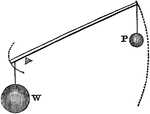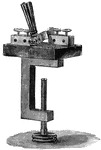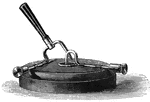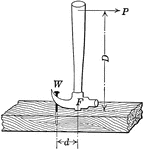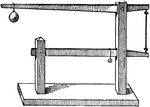
Arm Muscles in Action
Diagram of the muscles of the arm in action. Labels: 1, humerus; 2, ulna, 3, biceps muscle; 4, attachment…
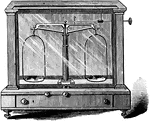
Balance
"The balance is essentially a lever of the first class, having equal arms. The beam carries a pan at…
Balance
"When bodies of equal weight are supported by the arms of a lever, they will balance each other when…
!["On this principle the common balance, represented [here] is constructed. A beam is poised on the top of a pillar, so as to be exactly horizontal. From each end of the beam, at equal distances from the fulcrum, a pan is suspended by means of cords. The object to be weighed is placed in one of these plans, and the weights in the other." —Quackenbos 1859](https://etc.usf.edu/clipart/36300/36337/balance2_36337_mth.gif)
Balance
"On this principle the common balance, represented [here] is constructed. A beam is poised on the top…
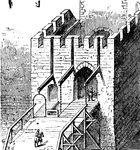
Draw Bridge
A bridge which may be drawn up or let down to admit or hinder communication, or to leave a transverse…
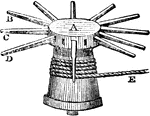
Capstan
"The capstan, in universal use, on board of ships, is an axle placed upright, with a head, or drum,…
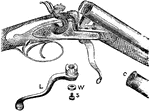
Central-fire Gun
"Central-fire Gun. C, central-fire cartridge; L, lever; W, washer; S, screw." — Encyclopedia Britannica,…
!["The common chipping-knife, used by apothecaries, and represented [here], is a familiar illustration of levers of the second kind [class]." —Quackenbos 1859](https://etc.usf.edu/clipart/36300/36342/chipknife_36342_mth.gif)
Chipping Knife
"The common chipping-knife, used by apothecaries, and represented [here], is a familiar illustration…
Compound Lever
"When several simple levers are connected together, and act one upon the other, the machine is called…
Compound Lever
"In compound levers, equilibrium is established when the power, multiplied by the first arms of all…
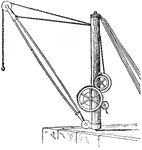
Derrick Crane
A crane in which the postis supported by fixed stays in the rear and the jib is pivoted like the boom…

Crowbar
"... shows one of the commonest (sic) forms in which this kind of lever appears,-the crowbar. The power…
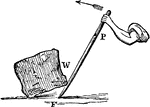
Crowbar and Stone
"... a farmer with a crowbar, as shown, can move a rock which with his hands alone he could not stir."…

Iron Age horse Cultivator
An Iron Age horse cultivator, good for working crops which require a horse cultivator. The levers can…
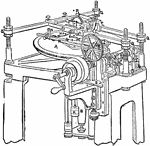
Dividing Engine
"The plate A is 46 inches in diameter, and is composed of gun metal. These were put on by original graduation,…

First Class Lever
"A lever is an inflexible bar freely movable about a fixed axis called the fulcrum. If the fulcrum is…

First Class Lever
"A Lever of the First Kind is one in which the fulcrum is between the power and the weight... where…
First Orders of Lever
In the first order of levers, the fulcrum is between the power and the weight.

Man with Lever and Fulcrum
"In mechanics, the point of rest about which a lever turns in lifting a body; also, a prop or support…

Hunting Shot Pouch
"Shot-pouches. A, pouch for one size of shot: a, pouch; b, charger with gates c, c'; d, spring which…

Hunting Shot Pouch
"Shot-pouches. ... B, pouch (shot-belt) for two sizes of shot: a, a', pouches; b, strap for attachment…
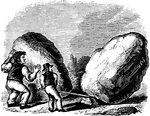
Knowledge is Power
"The engraving shows a large, powerful man, of giant size and strength, endeavoring to move a large…

Man Using Lever and Fulcrum to Lift Rock
"In mechanics, the word 'machine' signifies an instrument for the conversion of motion or the transference…

Lever
"The object W to be lifted is called the weight; the force is represented by P; the point, or pivot,…

Lever
"The object W to be lifted is called the weight; the force is represented by P; the point, or pivot,…
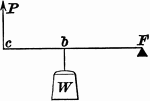
Lever
"The object W to be lifted is called the weight; the force is represented by P; the point, or pivot,…
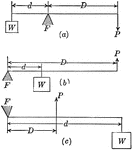
Lever and Fulcrum
Illustration of a lever with fulcrum F. W represents the weight lifted, P is the force that does the…
Lever Balanced on fulcrum With Weights
An illustration of a lever with weights m and n with distances a and b from fulcrum. Illustration could…
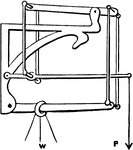
Compound Lever
"Sometimes it is not convienent to use a lever sufficiently long to make a given power support a given…

First Class of Lever: Fulcrum Between Power and Weight
This illustration shows the first class of lever. This class employs a fulcrum between the power and…

First Kind of Lever
"In straight levers of the first kind, the fulcrum is between the power and the resistance, as in fig…

Second Kind of Lever
"In the second order of levers, the resistance is between the fulcrum and the power; and, as before,…
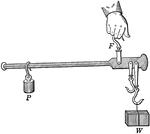
Steel-yard Used as a Lever
Illustration of an ordinary steel-yard being used as a lever. F represents the fulcrum. Weight P is…
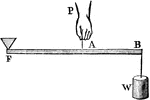
Third Kind of Lever
"In the third order of lever the power acts between the prop and the resistance, where also P : W ::…
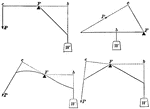
Simple Machines
Each of these are an example of the simple machine: lever. F c is the power arm and F w is the weight…

Magnetic Telegraph
"Morse magnetic telegraph will be understood by reference to the accompanying diagram, which represents…
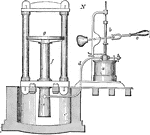
Hydraulic Press
A hydraulic press is a hydraulic mechanism for applying a large lifting or compressive force. It is…

Hydraulic Press
A hydraulic press is a hydraulic mechanism for applying a large lifting or compressive force. It is…
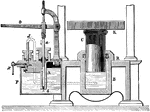
Hydraulic press
"Pascal's law finds an important application in the hydraulic press, in the more common forms of which…

Hydraulic Machine Exerting Pressure
Illustration of a hydraulic machine. "A principle known as Pascal's Law states that pressure exerted…
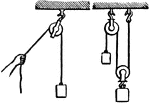
Pulley
"In the single fixed pulley (fig. 1) there is no mechanical advantage, the power and weight being equal.…

Pulley
"In a system of pulleys (figs. 3,4) in which the same string passes round any number of pulleys, and…

Pulley
"In a system in which each pulley hangs by a separate cord and the strings are parallel (fig. 5), there…

Purchase Shears for Cutting Metal
A tool used for cutting metals. "a and c, levers connected by a link bar b, and respectively pivoted…

Lever Safety-valve
A safety-valve, in which a weight is employed. Here a is the valve, b b the boiler, c c the valve-seat,…

Scale
"A common scale-beam, used for weighing, is a lever, suspended at the centre of gravity, so that the…

Scissors
"Many instruments in common use are on the principle of this kind of lever. Scissors, consists of two…
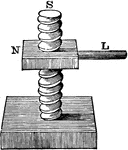
Screw Fixed Screw
"In this, the screw is fixed, while the nut, N, by being turned by the lever, L, from right to left,…
